This past June, the UK’s National Literacy Trust reported that while 3 in 5 (59.2%) young people surveyed said they would not share a news story if they weren’t sure it was true, only 1 in 2 (52.5%) would take the time to think about whether news stories were true or not.
Earlier in the year, the All-Party Parliamentary Group on Media Literacy reported that less than 50% of teachers think their pupils are media literate.
These new statistics follow up several earlier surveys; in 2018, for example, the commission on Fake News and the Teaching of Critical Literary Skills in School, reported that only 2% of young people in the UK “have the critical literacy skills they need to tell if a news story is real or fake.”

Information literacy, or the lack thereof, is a global concern.
What is information literacy, and why is it important?
According to the Association of College and Research Libraries, , information literacy is:
"the set of integrated abilities encompassing the reflective discovery of information, the understanding of how information is produced and valued, and the use of information in creating new knowledge and participating ethically in communities of learning."
Information literacy empowers people to learn for themselves so that they can make more informed decisions. It helps them recognize biases, understand context, and evaluate information so they can effectively use and communicate it. It’s a lifelong skillset that meaningfully impacts every person’s education, career, civic engagement, and personal life.
We’re drowning in a firehose of data
According to IDC, there was over 20 ZB of data on the internet (~22 trillion GB) in 2018. That equates to more than 60 billion GB of content being created every single day! Even more astounding: 90% of all that online data had been created in just the previous two years.
IDC predicts that by 2025, the global data sphere will be 175 ZB.
What does this mean? Well, now almost four billion people are drowning in information, but still starving for quality, trusted content.
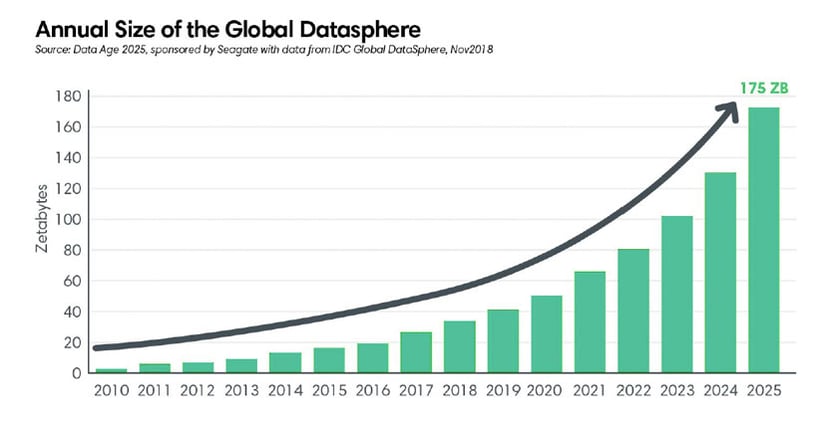
Today’s news never sleeps
The pervasive 24-hour content cycle may seem like a dream come true for news junkies, but for most people, it’s a nightmare. Driven by the desire for more eyeballs and speed, publishers’ continual recycling of stories with only minor updates is actually hurting us - distorting our perceptions of reality with over-sensationalized ‘breaking news’ that isn’t really news at all.
“The nasty little truth about 24-hour news — whether cable TV or the Internet — is that most of it is not news. Looks like news. Sounds like news. Smells like news. But nope, it isn’t news.”
Howard Rosenberg, Charles S. Feldman, Co-authors
No Time to Think: The Menace of Media Speed and the 24-Hour News Cycle
There’s never enough time for people to analyze any of it — meaning no time for proper critiquing or fact-checking. Media websites that are constantly being updated have become nothing more than a snacking tool, and a dangerous one at that.
In a recent Project Information Literacy (PIL) News Study Report, 68% of students surveyed said the amount of news available to them was overwhelming, with 51% saying it was difficult to recognize the most important news stories on any given day. And the intrusive nature of the news that finds them (even when they’re not looking for it) was frustrating for the majority.
“News interrupts my life a lot, especially when I’m on Facebook and I’m looking at friends’ pictures and enjoying myself and then there are videos about violence in Gaza, and I think, “Oh God, I can't avoid news!”
Female student, Life and Physical Sciences major
PIL study
Who can we trust?
Early in 2019, Mike Caulfield, director of blended and networked learning at Washington State University Vancouver, and head of the Digital Polarization Initiative of the American Democracy Project wrote a compelling article about the scarcity of attention. He insists that in our so-called ‘information age,’ content is becoming less and less valuable as it becomes more and more commodified.
It’s hard to argue with Caulfield when you look at the WAN-IFRA 2017 Outlook report and see that the majority of media organizations are just regurgitating over-published general news content from wire services.
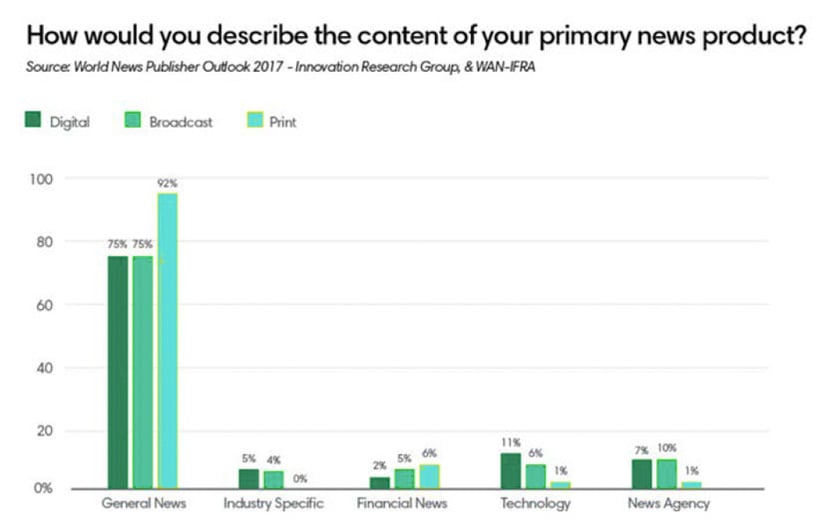
As a result of this commodifying of content, a student’s primary skill becomes their ability to make quick decisions about where best to focus their eyes and ears in a world where dubious outlets are vying to capture their attention and influence their beliefs, decisions, and behaviors.
In our attention-scarce world, Caulfield argues that everything is suspect - an assertion supported by the PIL study. 72% of those surveyed said that “without knowing the source of the news — where a news item originated — they could not trust a news item.”
“What I find with many students is they are trust misers — they don’t want to spend their trust anywhere, and they think many things are equally untrustworthy. And somehow they have been trained to think this makes them smarter than the average bear.”
Mike Caulfield, Director of blended and networked learning
Washington State University Vancouver
So, who’s trained them? It doesn’t appear to be those in academia, given the lack of attention information literacy is getting in many school curriculums.
According to PIL, only two out of the 18 institutions in their study had a full-term information literacy course requirement for all students to graduate. When it comes to students’ pathways to legitimate news, librarians are sadly underutilized. Students don’t know what they’re missing.
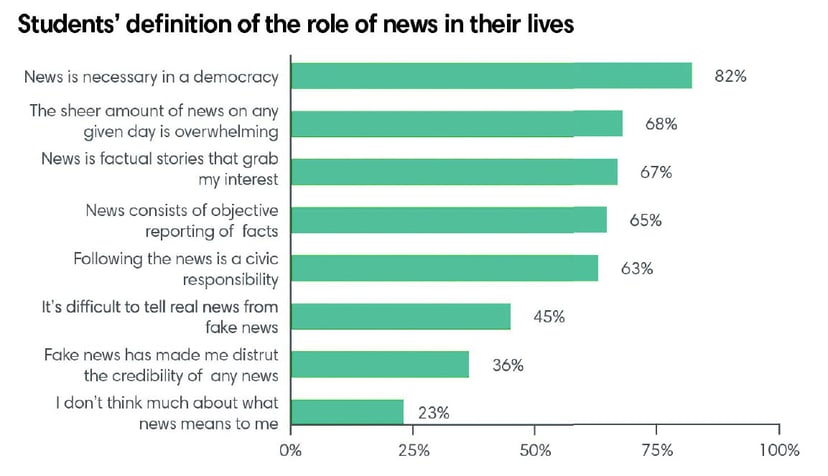
However, although students discover most of their news through friends and social media, and despite being overwhelmed by its sheer volume, they do recognize the importance of news in their lives.
They appreciate news’ value; they just need help finding the fact-based, trusted content that will serve them best in their studies and their lives.
Journalism today
Few would argue that since the advent of the internet, journalism’s challenges have been daunting. On almost a daily basis, we read about how news professionals all over the world face:
- Demands to do more with less
- Increased competition from social media, bloggers, and digital-only media
- Pressures to be first rather than be factual
- Massive layoffs
But despite all this, the core principles of journalism - accuracy, truth, impartiality, fairness, humanity, and accountability - still remain. And they resonate with people, including our youth.
74% of students in the PIL study said that they trusted professional journalists from traditional outlets more than social media sites that allowed anyone to post news. And many students automatically conferred authority and assigned trust to well-known sources like The Washington Post and The New York Times.
The war against fake news and propaganda isn’t over, but there are signs that the global public is becoming more vigilant. According to Edelman’s 2022 Trust Barometer, trust in the media was down in 15 of the 27 countries surveyed. While that’s a troubling statistic in some ways, it at least suggests that many media consumers are thinking more critically about what they see, hear, and read—and an increasing number have become wary of misinformation. In fact, 76% of respondents said they agreed with the statement, “I worry about false information or fake news being used as a weapon.”
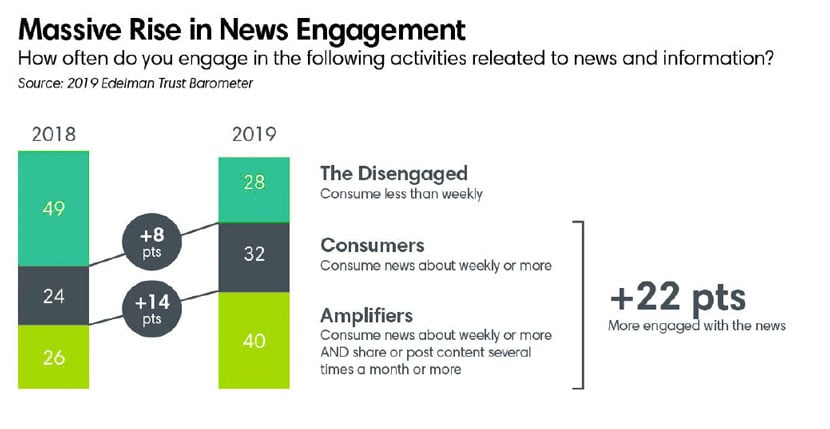
And as people seek out more reliable sources, traditional journalism bears a hallmark of trust.

Quality aggregation is the future of news
Content aggregation has always been a part of our lives. Before the internet, newspaper and magazine publishers aggregated stories and advertising into papers and periodicals. Music labels aggregated songs into albums, and cable companies aggregated video content for people’s TVs. And of course, libraries have always aggregated all forms of content, for patrons to enjoy.
But then came the web, and with it the rise of platforms and newsfeeds that changed everything.
Paid content aggregators typically monetize news through subscriptions and sometimes advertising.
A small selection of these also support sponsored access models, which allow consumer-focused businesses (e.g. libraries, hotels, airlines, cruise ships, ferries, and others) to pay upfront and provide access to thousands of newspapers and magazines for their users.
Free content aggregators make money off of advertising, of course, and sometimes user profile data that they collect and sell to others - often without users’ explicit consent.
In content aggregation, curation is crucial
Algorithmic curation, done right, targets an audience of one – an important distinction in the era of “It’s all about me.” Because content that isn’t personal is likely not relevant. And if it’s not relevant, it’s not useful.
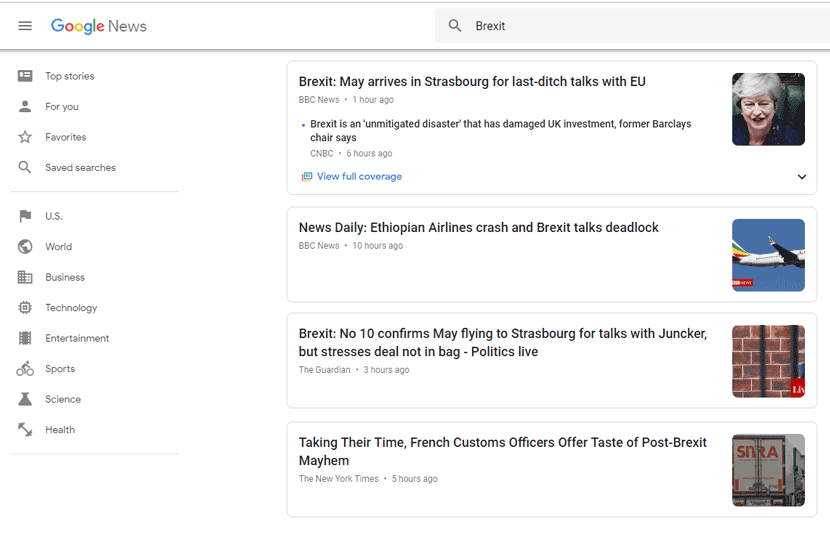
News consumers have also learned from other aggregators that you should never have to go searching for another piece of content. Take Spotify, for instance. Once a playlist, album, or song ends, Spotify will automatically play music which it ‘thinks’ you’ll like. And very often, its algorithm is right.
All content platforms, including news aggregators, use some form of machine learning to curate content for users – a strategy that is preferred by the majority of people, particularly the younger or tech-savvy ones.
People value the ‘independence of algorithms’ because they consider them to be less biased or swayed by editorial and political agendas. They also believe that algorithms help introduce them to a broader range of content and brands based on their interests and preferences, which are more topic-driven than bias-guided.
“It gets a variety of things – like I’m interested in certain topics that I probably wouldn’t find, or I’d have to search for it myself. So, it’s like a one-stop-shop of things that interest me.”
Focus group participant
‘Brand and trust in a fragmented news environment’ study
But as trusted as algorithmic curation is by many readers, it’s only as accurate as the data that drives it. If the data is inherently misinterpreted, incomplete, or manipulated (remember Facebook’s Trending Topics embarrassment?) the results can be anything from comical to catastrophic.
We’ve seen this far too often in the era of fake news, echo chambers, and duped readers who help spread misinformation and propaganda.
And then there’s bias. Whatever its form (political, economic, environmental, etc.), bias will always be a thing in the media world, even when you’re talking about the most trusted sources.
Sometimes the publisher is serving the interests of its owners by dictating what goes into an issue and what does not - something I’ve written about at length in The Insider magazine. Other times, it serves the interests of advertisers, who want to stage branded content as editorial.
And then there are publishers who are desperate to stand out in an ocean of content. By publishing deliberately biased content with clickbait headlines, they hope to attract more eyeballs, and the ad dollars they trust will follow.
We can’t escape bias; it’s part of the human condition. This is why it’s important that readers not only enjoy a personalized reading experience based on their interests (e.g. topics, sources, columnists, etc.) but that they’re also exposed to multiple perspectives in the content they read, not just at the local or national levels, but at the global level too.
“While good journalism aims for objectivity, media bias is often unavoidable. When you can't get the direct story, read coverage in multiple outlets which employ different reporters, and interview different experts. Tuning in to various sources and noting the differences lets you put the pieces together for a more complete picture.”
Kevin Arms, Librarian and archivist
Lake-Sumter State College
TEDx speaker on information literacy
Some aggregated news sites are algorithmically designed to share diverse global perspectives. Many platforms and publisher websites are not. Free content aggregators make money off of advertising, of course, and sometimes user profile data that they collect and sell to others - often without users’ explicit consent.
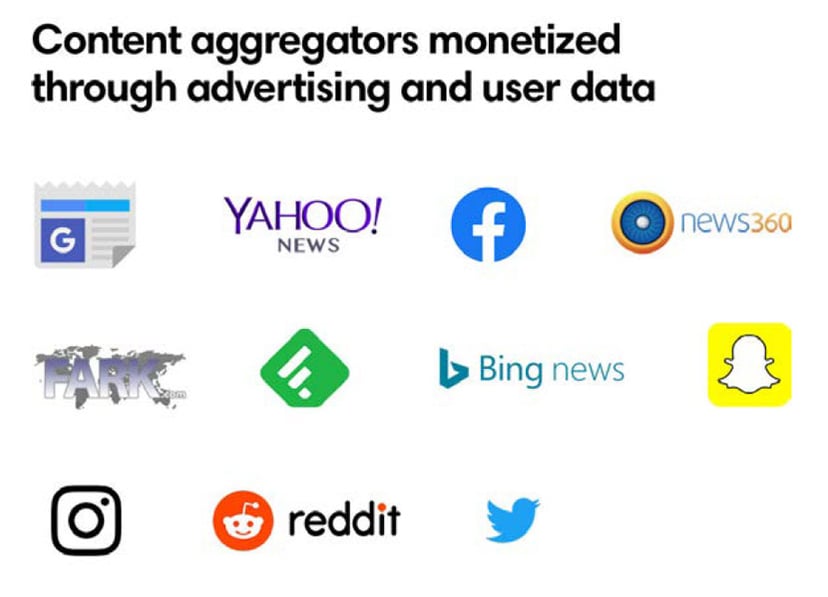
Librarians as pioneers and champions
The role of libraries and librarians in supporting our communities, enriching our schools, and sustaining our democracy cannot be overstated.
Their advocacy for equal access to content made them pioneers of the sharing economy when information was both scarce and highly valued.
So, it’s no surprise that libraries rank highly among our most trusted institutions, with librarians being considered one of the most trustworthy professions.
In almost every category of business, consolidation is inevitable, and the news industry is no exception. But instead of implementing smart consolidation to preserve the best journalism, what we’ve been seeing, especially in local media, is consolidation turned ugly. It’s happening almost on a monthly basis in North America and Europe. The common denominator throughout these consolidations has been an absent owner looking to capitalize on the struggles of the business.
By borrowing against the company’s assets, selling off unwanted properties, cutting newsroom staff, axing pension funds, and slashing other operational expenses, profit-driven proprietors are able to siphon off massive amounts of user data along with substantial profits from dividends, incentives, management fees, and tax breaks. Once the business has been exploited to the max, the owners who’ve made all their money back, either bankrupt it or sell it off.
In the US alone, close to 20% (~1,800) of metro and community newspapers have either merged or gone out of business since 2004. And it’s far from over.
So, who are stepping up to serve their communities and champion local journalism? You guessed it: librarians across the US and Canada are working hard (and often on their own time) to try and fill the void. But it’s a daunting task.
Librarians’ and educators’ roles in information literacy
“Students are hungry, we believe, for good models of engagement with news. They want to talk about news, both their frustrations and their longings for what they need from news providers. Accordingly, educators need to be more explicit about what a good “information diet” looks like, the drawbacks of being “always-on,” and, most of all, what habits a discerning news consumer practices.”
Project information literacy: How students engage with news
To help empower today’s youth in its quest for information literacy, the PIL study offered up six recommendations for educators, librarians, journalists, and social media platforms. Here’s a summary of those directed at specifically at librarians and educators:
- Integrate news discussions into the classroom;
- Help students learn more deliberately about the relevance of news;
- Consider a ‘writing across the curriculum’ program to help broaden student engagement with news, and encourage them to build connections between their news practices and their academic work;
- Help students understand the most effective way to vet and sort information.
Here are a few more I thought of:
- Make news literacy a mandatory subject in school, and offer it in public libraries as well.
- Help students learn where to spend their trust. Help them understand the risks of relying on social media and search engines for news sources.
- Open up the world of quality media to them, so they’re exposed to trusted news and information from around the world.
In the past, libraries offering printed media with a few select digital editions of periodicals and newspapers was sufficient to support the student body and teachers. At that time, Newspapers in Education programs adequately met a limited need for local and national news content. But today’s expectations far exceed these antiquated single-source solutions. The world of knowledge is at students’ fingertips, and they expect unlimited access to all it has to offer.
Moving forward
We all have a responsibility to be advocates for the truth, and suppressors of lies, hoaxes, ‘alternative facts,’ misinformation, and propaganda.
In 2022, let’s make a commitment to seek out and support quality journalism, and shun that which is not.
Let’s help those who struggle with information literacy by teaching them how to differentiate fact from fiction.
Because as Professor Brendan Nyhan from Dartmouth College once said, “Standing up for facts is a kind of patriotic act and a necessary one."









